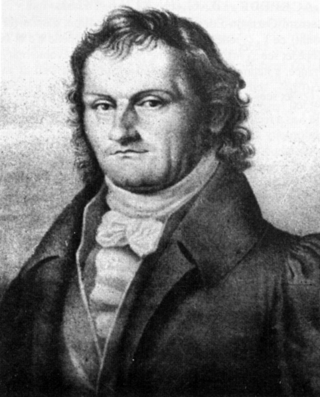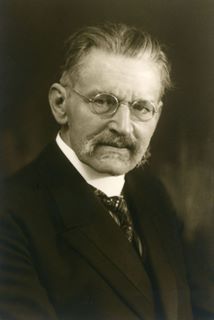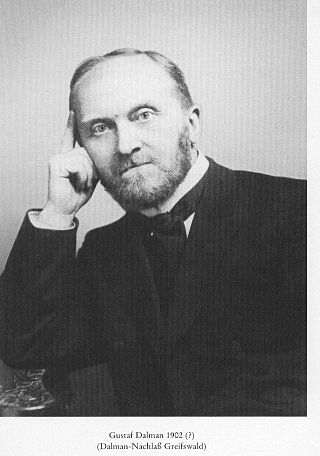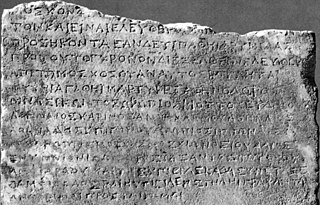Related Research Articles
Franz Ludwig Carl Friedrich Passow was a German classical scholar and lexicographer.

Johann Gottlob Theaenus Schneider was a German classicist and naturalist.

Heinrich Friedrich Wilhelm Gesenius was a German orientalist, lexicographer, Christian Hebraist, Lutheran theologian, Biblical scholar and critic.
A Greek–English Lexicon, often referred to as Liddell & Scott or Liddell–Scott–Jones (LSJ), is a standard lexicographical work of the Ancient Greek language originally edited by Henry George Liddell, Robert Scott, Henry Stuart Jones, and Roderick McKenzie and published in 1843 by the Oxford University Press.
Johann Gottfried Flügel was a German lexicographer.

Baron Hermann von Soden was a German Biblical scholar, minister, professor of divinity, and textual theorist.

Walter Bauer was a German theologian, lexicographer of New Testament Greek, and scholar of the development of Early Christianity.
Riekele or Rykle Borger was a notable Dutch Assyriologist educated in the German tradition. He was the protégé of Wolfram von Soden, and taught as professor in the Seminar für Keilschriftforschung at the University of Göttingen, Germany.

Richard August Reitzenstein was a German classical philologist and scholar of Ancient Greek religion, hermetism and Gnosticism. He is described by Kurt Rudolph as “one of the most stimulating Gnostic scholars.” With Wilhelm Bousset, he was one of the major figures of the Religionsgeschichtliche Schule.

Gustaf Hermann Dalman was a German Lutheran theologian and orientalist. He did extensive field work in Palestine before the First World War, collecting inscriptions, poetry, and proverbs. He also collected physical articles illustrative of the life of the indigenous farmers and herders of the country, including rock and plant samples, house and farm tools, small archaeological finds, and ceramics. He pioneered the study of biblical and early post-biblical Aramaic, publishing an authoritative grammar (1894) and dictionary (1901), as well as other works. His collection of 15,000 historic photographs and 5,000 books, including rare 16th century prints, and maps formed the basis of the Gustaf Dalman Institute at the Ernst Moritz Arndt University, Greifswald, which commemorates and continues his work.

Felix Wilbur Gingrich was an American educator, scholar of Biblical Greek, and Christian layman who spent his entire career working with students at Albright College in Reading, Pennsylvania. Gingrich published many books and articles, including a definitive translation of a Greek-English lexicon of the New Testament.
Lectionary 143, designated by siglum ℓ143 is a Greek manuscript of the New Testament, on parchment leaves. Palaeographically it has been assigned to the 8th-century.

Barbara Aland, née Ehlers is a German theologian and was a professor of New Testament Research and Church History at Westphalian Wilhelms-University of Münster until 2002.
Arexion was a seer. He served under Xenophon with the Ten Thousand in the Persian Expedition recorded by Xenophon in his work, the Anabasis. He was the presiding soothsayer during this expedition after Silanos from Ambracia deserted the army. As a soothsayer he practiced extispicy, the observance of animal entrails to foresee future events. He is also referred to as Arexion the Arcadian which indicates he was a native of Arcadia, a region in the center of the Peloponnese.

Ioudaios is an Ancient Greek ethnonym used in classical and biblical literature which commonly translates to "Jew" or "Judean".
Frederick William Danker was a Christ Seminary–Seminex Professor Emeritus of New Testament at the Lutheran School of Theology at Chicago, Illinois. Danker was a noted New Testament scholar and the pre-eminent Koine Greek lexicographer for two generations, working with F. Wilbur Gingrich as an editor of the Bauer Lexicon starting in 1957 until the publication of the second edition in 1979, and as the only editor from 1979 until the publication of the 3rd edition, updating it with the results of modern scholarship, converting it to SGML to allow it to be easily published in electronic formats, and significantly improving the usability of the lexicon, as well as the typography.
Johann Georg Wilhelm Pape was a German classical philologist and lexicographer. He is known today primarily as the author of his Griechisch-Deutsches Handwörterbuch [Concise Greek-German Dictionary], first published in 1842 and frequently reprinted in the 19th and early 20th centuries.

Immanuel Johann Gerhard Scheller was a German classical philologist and lexicographer.
Georg Aenotheus Koch was a German classical philologist and lexicographer.
References
- ↑ Rykle Borger, "Remarks of an Outsider about Bauer's Wörterbuch, BAGD, BDAG, and Their Textual Basis," Biblical Greek Language and Lexicography: Essays in Honor of Frederick W. Danker, Bernard A. Taylor (et al., eds.), pp. 32–47.
- ↑ Preuschen, D. E. (1908). "Vollständiges Griechisch-Deutsches Handwörterbuch zu den Schriften des Neuen Testaments und der übrigen urchristlichen Literatur" [Full Greek-German Concise Dictionary of the New Testament writings and other early Christian literature]. Zeitschrift für die Alttestamentliche Wissenschaft [Journal of Old Testament Studies] (in German). 28 (4). doi:10.1515/zatw.1908.28.4.U.